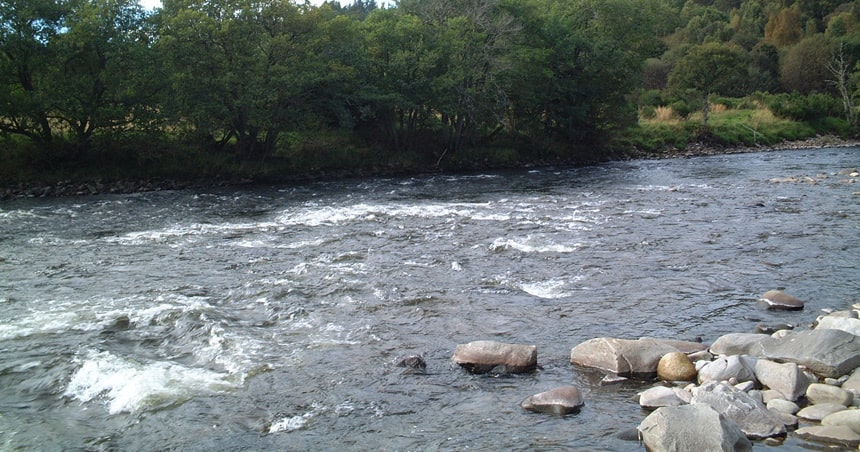The River Spey is the home of speycasting and one of Scotland’s big four salmon rivers. It has the third largest drainage area after the Tay and Tweed and is the second longest after the Tay. However, its major attraction is its size and the strength of its stream – in the middle and lower river it falls on average 12 feet per mile – the gradient and volume of flow produce a unique experience for the angler.
An interesting aside, the Spey, unlike most British rivers, does not have a sizeable town at its mouth. The river is snow fed from the Cairngorm Mountains and in a good year this can mean the river staying high until early June.
Fishing Tackle.
The tackle required depends on the time of year and where you are fishing. If fishing the lower or middle Spey stout tackle will be needed during the spring and autumn, and even in the summer if there happens to be a flood.
When fishing in the spring or autumn long rods of around 15-16ft rods are used by many experienced Spey anglers, often with intermediate or sinking lines and/or sink tips. In the summer a 13-15ft rod with a floating line is usually sufficient although in times of drought a single-handed rod may suffice. It is advisable to ensure that your reel has plenty of backing as a large fish in a strong current can take a lot of line. Salmon are not known as leader shy so do be frightened to fish with 15-18lb nylon in the spring and nothing less than 10lb in the summer.
The choice of flies depends on the time of year you intend to fish and the height of the water. In the spring ‘any fly will do as long as it is a Willie Gunn’ is a commonly heard expression. During the summer months try shrimp patterns like General Practitioner, Ally Shrimp and Cascade – and who would dare fish the Spey without a Munro Killer in their box? In low water conditions a member of the Stoat’s Tail family is always good for grilse.
Waders and Clothing.
Chest waders are usually required on most beats. These can be hired or bought and can be a good investment. Neoprene waders or breathables with several under layers are required in the spring and will help keep out the chill although as the year progresses breathables will be most suitable. Warm waterproof clothes are also advisable as the weather in Scotland can be unpredictable; it is easy to take off a layer if you get too warm. In the interests of safety a floatation aid is highly recommended and is compulsory on some beats. Given the power of the Spey flow a stout wading stick is also advised.
Spey Fishery Board Salmon Conservation Policy
Scottish legislation requires that all salmon caught before the 1st April must be released. In order to protect the integrity of the Spey stock and to maximise their spawning potential, the Spey Fishery Board’s policy is that all fish caught up to and including the 31st May should be released alive. From the 1st June the policy set out below will apply.
1. Catch and release: Salmon
- All hen salmon and hen grilse must be released throughout the season
- Each angler must return the 1st, 3rd, 5th etc. cock fish caught
- Throughout the season all stale or gravid fish must be released
- Escaped farmed salmon must be retained.
Catch and release: Sea trout
- All sea trout larger than 3lb/50cm/20″ must be released
- All sea trout/finnock smaller than 1lb/35cm/14″ must be released
- Each angler should only retain a maximum of one takeable sea trout per calendar day. Anglers are also encouraged to release their first fish and keep the second that is of takeable size
- All unseasonable fish e.g. coloured fish, kelts, over wintered finnock and smolts must be returned
- Release all stale or coloured fish
2. Method: Where possible anglers should be encouraged to fish with a fly; All hooks should be ‘pinched’ or barbless; Where spinning is allowed only one set of barbless hooks may be used on a lure.
3. Fishing effort: Where possible the numbers of hours and rods fished should be limited.
Conservation Policy: The 2020 Conservation Policy can be found here.

